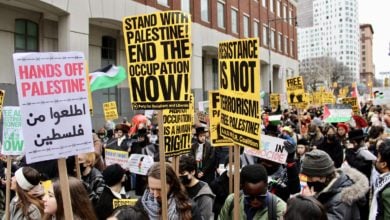On Dec. 23, 2006, the United Nations Security Council unanimously approved Resolution 1737, requiring Iran to suspend all of its uranium enrichment and reprocessing activities. According to the resolution, “all states shall take necessary measures to prevent the supply, sale or transfer directly or indirectly … of all items, materials, equipment, goods and technology that could contribute to Iran’s enrichment-related, reprocessing or heavy-water activities.” These measures also include freezing the funds of certain Iranian companies and individuals involved in transactions related to Iran’s nuclear projects.
The resolution was the outcome of over two months of negotiations during which the United States relentlessly pushed
|
Russia and China played a moderating role, making their eventual consent to the resolution contingent upon removing the travel ban on Iranian officials and insisting on the inclusion of a phrase that the resolution could not be regarded as a basis to use military force against Iran.
In its final form, Resolution 1737 is far less intrusive than what the United States wanted. In pursuit of its strategy in the region, however, the United States found it advantageous to have some kind of U.N. sanctions against Iran on record and implemented, rather than having none at all.
There was pressure to pass a resolution before the beginning of 2007, when the new composition of the Security Council member states was likely to make it harder to pass resolutions against Iran. Getting punitive sanctions approved against Iran was particularly challenging because the demand for Iran to freeze its nuclear activities is entirely baseless under international law.
Iran has called the resolution illegal and declared that it would continue its work on the development of nuclear technology for peaceful purposes. Referring to the resolution, Iran’s ambassador to the United Nations, Mohammad Javad Zarif, said: “A nation is being punished for exercising its inalienable rights.”
Iran is, in fact, a signatory of the Nuclear Non-proliferation Treaty. The International Atomic Energy Agency has inspected Iran’s nuclear sites hundreds of times. The sites continue to be open to IAEA inspectors. Time and time again, the agency has declared that there is no evidence that Iran has a nuclear weapons program.
Real nuclear weapons powers
What strips the resolution of any legitimacy or pretense of legality is the existence of countries in the region that already have nuclear weapons and are subject to no international pressures. Foremost among them is Israel, armed with an estimated 200 nuclear warheads. Israel, of course, is not a signatory of the NPT and has never even been considered for any possible sanctions.
On separate occasions in December 2006, Israeli Prime Minister Ehud Olmert and incoming U.S. Secretary of Defense Robert Gates acknowledged Israel’s possession of nuclear weapons. The admissions departed from the longstanding policy of “nuclear ambiguity” regarding Israel’s nuclear stockpile.
“It is indisputable that nuclear weapons in the hands of the Israeli regime with an unparalleled record of noncompliance with Security Council resolutions … poses a uniquely grave threat to regional and international peace and security,” said Zarif in an address to the Security Council.
Another country whose nuclear weapons program lays bare the hypocrisy of the imperialist claim of concern about nuclear proliferation is India. On Dec. 18, President Bush signed a nuclear deal with India, declaring: “India has conducted its civilian nuclear energy program in a safe and responsible way for decades.” The deal makes India the recipient of U.S. assistance in nuclear technology. India, of course, has built nuclear bombs, has conducted several nuclear test explosions, has refused to sign the NPT and has implicitly threatened Pakistan with the use of its nuclear weapons. The deal signed by Bush will keep India’s eight military nuclear plants off-limits to any kind of inspections.
In contrast to Israel, India and Pakistan—all acknowledged nuclear powers—Iran is being sanctioned on the basis of a totally unsubstantiated suspicion that it is pursuing a weapons program, despite having subjected itself to an extensive inspections regimen. And, of course, there is the question of why imperialist powers are entitled to have thousands of nuclear weapons capable of annihilating the planet many times over while an oppressed country’s pursuit of nuclear technology is a grave threat to humanity.
The real goals of sanctioning Iran
If the United States, aided by its imperialist allies, lacks consistency regarding the application of international law, its pursuit of the strategic goal of reshaping the world in the interests of maximizing capital’s potential to realize profits is remarkably consistent.
Israel represents the strongest, most stable U.S. ally in the Middle East. It is a key component of the U.S. drive for domination.
India, while not a U.S. client state, represents a significant component of U.S. strategy toward China. The essence of
|
Iran represents an impediment to imperialist aims. Iran is following an independent path of economic development and is politically not beholden to the dictates of Washington.
As a supporter of Palestinian and Lebanese resistance, Iran remains a threat to Washington and Tel Aviv.
The stated U.S. strategy toward Iran is regime change. Despite tactical differences, other imperialists share Washington’s aim of bringing down the Iranian regime. If an imperialist-friendly regime is installed through Washington’s multilateral approach, investment opportunities in Iran’s vast resources and markets will abound for all imperialists.
The only thing that curbs the appetite of the imperialists is the reality of mass resistance. In pursuit of the same regional interests, the United States invaded Iraq in 2003. But the widespread resistance of the Iraqis has kept Washington’s dream of a stable, investment-friendly Iraq with its resources open to imperialist plunder far from being materialized.
Resistance from the people of Iran, Syria, Lebanon and Palestine stands in the way of Washington’s hope of a major realignment of the forces in the region—its dream of redrawing the map of the Middle East.
The danger of an attack
While an all-out U.S. invasion of Iran is not a possibility for the time being because U.S. forces are tied up battling Iraqi resistance, aerial bombings and other forms of military aggression are not out of the question. As the U.S. administration is at a loss for options in Iraq—with the possibility of containing the resistance seeming more remote than ever—a military escalation and a regional expansion of U.S. hostilities is a distinct possibility.
This is why the struggle of activists in the U.S. anti-war movement, particularly its anti-imperialist wing lead by the ANSWER Coalition, is critical. Washington is not just concerned about the resistance it encounters in the countries that it occupies, invades, bombs and dominates. It is also worried about a growing and deepening anti-war movement in the United States. The more Washington is challenged by a strong, militant movement likely to expand and radicalize, the less likely it is to launch a new militaristic adventure.
U.S. hands off Iran!








